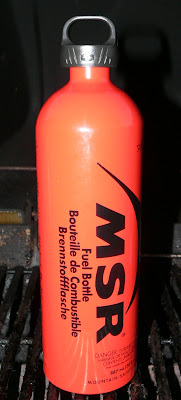The Dragonfly comes with two interchangeable jets that allow you burn any one of several fuels. The factory installed jet allows for the burning of white gas/naphtha or unleaded gasoline. The other jet burns kerosene, diesel, or aviation fuel. White gas is the purest and most preferred fuel, white gas being essentially unleaded gas without additives. The fuel canister is not included and comes in 11, 22, and 30 oz. sizes. I have a 30 oz. can.
The Dragonfly folds up for storage.
And when unfolded has a very sturdy pot-stand.
Once you have filled your fuel canister with fuel, the fuel pump is inserted into the canister and sealed, then given 20-30 pumps by hand to build up pressure. A few pumps can be added during longer cooking periods to maintain the appropriate pressure.
Then open the valve near the burner, slowly allowing a half spoonful of fuel into the primer then close the valve. Using a flame source, ignite the fuel in the primer through the hole in the side. The fuel should burn for about a minute then begin to die out. At this point the burner should be hot enough to atomize the fuel when you open the valve and fuel exits the jet.
The Dragonfly stove has a simmering valve that allows for fine tuning of the flame. The flame can be lowered sufficiently to simmer rice without scorching or raised to full for boiling. One of the few complaints I have heard about this stove is that when the valve is fully open the stove is very loud. I have to disagree. It does make some noise, but nothing like I had imagined from the reviews I have read.
So far I have cooked a single portion of my Mexican rice, and a bowl of grits. Both came out great with no scorching. I have no doubt that if I can procure the produce, I will be eating well on the road.
Nice pot of grits simmering away.










No comments:
Post a Comment